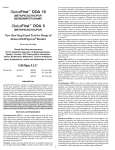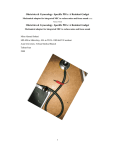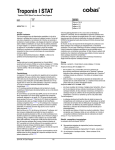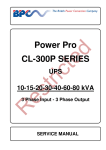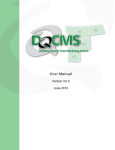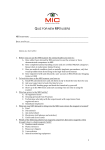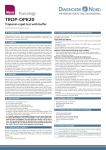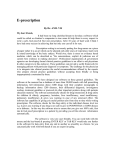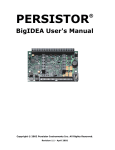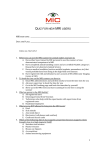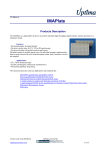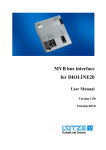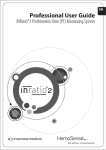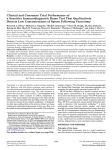Download TnI Troponin l
Transcript
REF TM 60501 Catalog number TnI Troponin l For the Rapid, Quantitative Determination of Troponin I in human Whole Blood, Plasma or Serum MF Manufacturer: Princeton BioMeditech Corporation 4242 US Route 1 Monmouth Junction, NJ 08852 www.pbmc.com Manufactured for: LifeSign LLC 71 Veronica Avenue Somerset, NJ 08873 Tel: 1 800. 526.2125 www.lifesignmed.com Authorized Representative: MT Promedt Consulting GmbH Altenhofstrasse 80 66386 St. Ingbert, Germany +49-68 94-58 10 20 P-56611 Version # 226-10/24/06 Status First™ TnI Explanation of Symbols CE Marking of Conformity Manufacturer Catalog number Expiry date/Use by Lot number In Vitro Diagnostic medical device Consult instructions for use Store between 2°C and 8°C Manufactured for European Authorized Representative Contents Test Device Data Chip Package Insert PIP PIP PIP PIP PIP PIP PIP PIP PIP PIP PIP PIP PIP PIP PIP PIP PIP PIP PIP Desiccant Transfer Pipette Intended Use: For the quantitative determination of Troponin I as an aid in the diagnosis of myocardial infarction and acute coronary syndrome Contains sufficient for <n> tests Do not reuse Status First™ TnI For in vitro diagnostic use Intended Use StatusFirst™ TnI (Troponin I) is a rapid test for in vitro quantitative determination of Troponin I in human whole blood, plasma or serum. The device is intended for use with the DXpress™ Reader to provide quantitative results as an aid in the diagnosis of myocardial infarction and acute coronary syndrome (ACS). Summary and Explanation Acute coronary syndrome (ACS) is the leading cause of morbidity and mortality among both men and women, affecting more than 13.9 million people in the US. The presentation of ACS is varied and symptoms may develop suddenly, with acute myocardial infarction (AMI) being the most dramatic of presentations. Annually, AMI affects approximately 1.1 million people in the US, with a 30% mortality rate. The World Health Organization recommends diagnosis of AMI with a positive indication on at least two of these three criteria: (1) patient history and physical examination; (2) electrocardiogram; (3) changes in blood levels of cardiac protein markers.1 Patient history and physical examination are critical and must be considered, but often provide insufficient information to differentiate AMI from other cardiac abnormalities. Electrocardiogram, together with the patient history and physical examination, is useful but diagnostic in only about 50% of AMI patients. ST segment elevation or depression and Q wave formation are typical indicators of AMI. Patients hospitalized with ACS have been found to be high risk ST-segment elevation myocardial infarction (STEMI) or moderate-high risk non-ST-segment elevation myocardial infarction (NSTEMI) patients.2 However, it may be difficult to diagnose AMI in NSTEMI patients.3 Therefore, measurement of sensitive and specific cardiac protein markers in the blood provides an extremely useful differential diagnostic tool enabling prompt management of patients presenting with symptoms of AMI. Troponin I and troponin T are two specific contractile proteins of the cardiac muscle regulatory complex that have gained popularity as cardiac specific markers for AMI. Three subunits of the troponin complex (I, T, C) are bound with tropomyosin to actin in the thin filament of the myofibril. Cardiac troponin I (cTnI) prevents muscular contraction and is exclusively present in the cardiac muscle.4 The Troponin complex, together with tropomyosin, forms the main component that regulates the Ca2+ sensitive ATPase activity of actomyosin in striated muscle (skeletal and cardiac).5 Different isoforms of TnI exist in the skeletal and cardiac muscles (sTnI and cTnI, respectively) with distinct structural heterogeneity between these isoforms that allow Page 1 the production of isoform-specific antibodies.6 Specifically, the amino terminal amino acid sequence of cTnI has 31 amino acid residues that are not present in sTnI. The utility of determining the serum levels of the different isoforms of TnI has been studied.7 Detection of cTnI in the serum has been investigated as an aid in the determination of myocardial damage in patients with AMI.8 Determining the serum level of cTnI provides diagnostic value in identifying patients with AMI. The temporal relation of release of cTnI into the serum has been investigated and compared to the other established cardiac markers, such as creatine kinase MB (CK-MB), myoglobin and Troponin T.9,10 Following AMI, cTnI is released into the circulation with levels exceeding the upper reference limit of normal within 4–6 hours, and peak levels are reached after 12-24 hours.11 This early release profile is similar to CK-MB. However, CK-MB levels return to normal values in about 72 hours, while levels of cTnI remain elevated for 5–7 days. The release of cTnI into the blood involves myocardial damage, primarily as a result of AMI; however, such damage may occur from causes other than AMI, such as unstable angina, congestive heart failure, and ischaemic damage due to coronary artery by-pass surgery.13 Further, the distinct structure of cTnI and the availability of highly specific detection methods for cTnI have increased the utility of this marker for the diagnosis of AMI in complex clinical conditions that involve skeletal muscle damage. The high specificity of cTnI measurements for the identification of myocardial damage has been demonstrated in conditions such as the perioperative period, after marathon runs, and following blunt chest trauma.11,12 Levels of other, non-cardiac specific protein markers such as CK-MB and myoglobin are typically elevated in the blood following such skeletal muscle damage.14,15 Principle The StatusFirst™ TnI test device utilizes biotin coupled anti-TnI antibody/streptavidin solidphase chromatographic immunoassay technology to quantitatively determine the concentration of TnI in human whole blood, plasma and serum specimens. After a sample has been dispensed into the sample well, the StatusFirst™ TnI test device is placed in the DXpress™ Reader. The DXpress™ Reader displays the TnI concentration 15 minutes after sample addition. The DXpress™ Reader is programmed to convert the intensity of the test band (as indicated by the “TnI” line on the test device) into a concentration of TnI automatically by using lot specific calibration factors supplied with each box of test devices. The TnI concentration in the sample correlates with the intensity of the test band. Reagents The StatusFirst™ TnI test device contains all required reagents including dye conjugated monoclonal anti-TnI antibody, biotin conjugated polyclonal anti-TnI antibody and streptavidin immobilized at the test band. No other reagents are required. Page 2 Materials Provided Each box contains the following: • 20 StatusFirst™ TnI test devices, each individually sealed in a foil pouch with a desiccant and a single use transfer pipette. • 1 lot specific Data Chip with calibration information • 1 package insert Materials/Equipment Required But Not Provided 1. DXpress™ Reader, part no. LSR-2000 2. Commercially available TnI Controls for external Quality Control (QC) Precautions and Warnings • For in vitro diagnostic use only. • Carefully follow the instructions for use. • Wear disposable gloves while handling patient samples. • Patient samples, used test devices and transfer pipettes should be treated as if potentially infectious and should be discarded as biohazard materials according to local regulations. • Thoroughly wash hands afterwards and observe the appropriate regulations/procedures for disposal of all used materials (samples, test devices, and transfer pipettes). • The result obtained from the StatusFirst™ TnI test device does not provide a definitive diagnosis and should be interpreted by the physician in conjunction with other laboratory test results and patient clinical findings. • Avoid cross contamination of samples by using a new transfer pipette for each sample. • Keep the test device in the sealed pouch until ready for use. • Do not use the test device if the pouch is damaged or the seal is broken. • Do not use the test device after the expiration date printed on the pouch. • This is a quantitative test and therefore no visual interpretation of the result should be made. • The test must be read at 15 minutes after sample addition to ensure an accurate result. Storage and Stability • Store the StatusFirst™ TnI test device between 2° and 8°C (35° to 46°F) until the expiration date printed on the pouch is reached. • The StatusFirst™ TnI test device in its sealed pouch is stable at room temperature (18° to 30°C/ 64° to 86°F) for 15 days, provided the expiration date printed on the pouch is not exceeded. Page 3 Sample Collection and Preparation • The StatusFirst™ TnI test device is to be run using whole blood, serum or plasma samples collected using EDTA or lithium heparin as the anticoagulant. • Whole blood samples must be tested within 4 hours and plasma or serum samples must be tested within 8 hours of collection. • Whole blood, serum or plasma samples should be stored and/or transported in refrigerated conditions. • If longer storage is required, plasma or serum samples should be kept frozen at -20°C (-4°F) or lower. • Allow patient samples to equilibrate to room temperature prior to testing. • Grossly hemolyzed samples should not be used. • Mix the blood specimen gently inverting the tube several times before using. • For frozen samples, thaw completely and mix thoroughly before use. PROCEDURE DXpress™ Reader Consult the DXpress™ Reader User Manual. For DXpress™ Reader installation, startup and complete instructions refer to the DXpress™ Reader User Manual. The operator must consult the DXpress™ Reader User Manual prior to use and become familiar with the processes and quality control procedures. QC Procedure Self Check Each time the DXpress™ Reader is turned on, Self Check is automatically performed. Self Check takes about 15 seconds. PASS or FAIL results will be displayed/printed when testing is completed. All Self Check items should pass before testing patient samples. The operator may then proceed to “Calibration QC.” If the DXpress™ Reader is left on or in power save mode, the operator should perform Self Check daily as follows: 1. From the Main Menu, select [2] RUN QC. 2. Select [1] SELF CHECK. 3. Self Check takes about 15 seconds. PASS or FAIL results will be displayed/printed when testing is completed. PIP Page 4 Calibration QC Each day of patient testing, use the Calibration Set (see DXpress™ Reader manual) to ensure the DXpress™ Reader functions properly: 1. From the Main Menu, select [2] RUN QC. 2. Select [2] CALIBRATION QC. 3. Scan (or manually enter) the Operator ID barcode. 4. Scan the Calibrator ID barcode, found on the back of the Calibrator. 5. Insert the Calibrator into the reader – be sure to close the Tray – and press ENTER. Follow prompts displayed on the screen. 6. Calibration QC result will be displayed/printed when the calibration is completed. Calibration QC should pass before running daily patient testing. 7. Blank Calibration is not necessary for TnI product. Select [CANCEL] and press ENTER. External QC Perform External QC once for each new lot of StatusFirst™ TnI test devices. 1. From Main Menu, select [2] RUN QC. 2. Select [3] EXTERNAL QC. 3. Using external controls, follow the same procedure as if running a patient sample; see section “Testing Patient Sample Procedure” below. The only difference is that RUN PATIENT requires a Patient ID, whereas EXTERNAL QC requires a Sample ID. Uploading Lot-Specific Calibration Information using the Data Chip When you start to use a new lot of test devices, the Reader will prompt the operator to insert the Data Chip that is supplied in the test kit. Insert the Data Chip with the corresponding test device lot number, select OK to continue and follow the prompts. Page 5 Testing Patient Sample Procedure There are three modes of testing patient samples (Read-Now, Batch, Scheduler). The operator is free to choose the mode most suitable for the particular task at hand. The Scheduler mode is described below as an example: 1. Open the pouch and remove the test device. 2. Label the test device with the patient ID. 3. Place the test device on a level surface. 4. Testing the Patient Sample on the DXpress™ Reader: • From the Main Menu, select [1] RUN PATIENT. • Scan (or manually enter) lot number barcode from the pouch. • Confirm test device information (type of test device and lot number) as displayed on the screen and press ENTER. • Scan (or manually enter) the Operator ID barcode. • Scan (or manually enter) the Patient ID barcode. • Select either Blood or Plasma/Serum, as appropriate. • From the Incubation Time window, select SCHEDULER. • Within 30 seconds do the following: Draw patient sample solution up to the line on the transfer pipette while holding the transfer pipette vertically, and dispense into the sample well. When drawing sample into the transfer pipette, avoid introducing air bubbles. Do not touch the sample well or test device with the tip of the transfer pipette. Fill sample up to line • Press ENTER. • Insert the test device in the Reader tray, close the Reader tray. • After 15 minutes of incubation the DXpress™ Reader will automatically display the results on the screen. • Results may be printed by pressing the PRINT button. • At this point the test device may be removed and appropriately discarded. Report and Interpretation of Results • The range of TnI concentrations reported by the test device system is 0.05 ng/mL to 30 ng/mL. Results below or above this range will be shown as < 0.05 ng/mL or > 30 ng/mL, respectively. • Valid results will be displayed on the Reader as: Control: Valid TnI: xx.xx ng/mL • Invalid results: If the sample fails to migrate properly or the reagents fail, the Reader will display: Control: Invalid*** TnI: Invalid*** In this case, repeat the test with a new test device. Page 6 Recommended Decision Threshold Values The clinical cutoff of StatusFirst™ TnI was determined as 0.2 ng/mL TnI when compared to Access® AccuTnI™† and Triage® Cardiac Panel††. However, laboratories should establish their own diagnostic cutoff concentration based on the clinical practice at their respective institutions. Registered trademark of Beckman Coulter Registered trademark of Biosite † †† QUALITY CONTROL External Controls Good laboratory practice includes the use of external controls to ensure proper test device performance. It is recommended that prior to using a new lot or shipment of StatusFirst™ TnI test devices, the performance of the lot be confirmed by testing with external controls (see section “Materials/Equipment Required But Not Provided”) to ensure the test devices will deliver the correct test result. The frequency of QC testing should be determined according to individual laboratory standard QC procedures. Upon confirmation of the expected results, the test devices are ready for use with patient samples. If external controls do not perform as expected, do not use the test devices and contact LifeSign Technical Services at 1-800-526-2125. Internal Controls StatusFirst™ TnI test device has a built-in control that satisfies the requirements of testing a control on a daily basis. The control line is an internal positive procedural control. A distinct reddish-purple control line should appear at the control position if the test is performed properly, an adequate sample volume is used, the sample and reagent are wicking on the membrane, and the reagents at the control line are reacting with the conjugate-color indicator. In addition, a clear background may be considered a negative procedural control. If the test is performed correctly and the device is working properly, the background in the result window will become clear and provide a distinct result. The DXpress™ Reader will report “Control: Valid” and the test result for TnI concentration in ng/mL unit when Internal Control QC is satisfied. LIMITATIONS • The results of the StatusFirst™ TnI test should be used in conjunction with the total clinical presentation of the patient and other laboratory information available. Medical decisions should not be based on a single point in time test result of the StatusFirst™ TnI test. The published guideline recommends collecting at least three blood samples during the early triage period.16 • Other substances and/or factors not listed, e.g., technical or procedural errors, may interfere with the test and cause false results. Page 7 PERFORMANCE CHARACTERISTICS Limit of Detection The limit of detection (LoD) represents the lowest concentration of TnI that can be reliably differentiated from zero. The LoD of 0.05 ng/mL was determined according to Clinical and Laboratory Standards Institute (CLSI) guideline EP17-A. Limit of Quantitation The limit of quantitation (LoQ) is the lowest TnI concentration that can be reproducibly measured with a total coefficient of variation of at most 20%. The LoQ was determined to be 0.1 ng/mL. Linearity Human cardiac troponin complex from the National Institute of Standards & Technology (NIST) was spiked into human blood to a final concentration of 32 ng/mL cardiac troponin I, and then plasma was separated from the whole blood. The plasma from the spiked blood was 2-fold serially diluted into troponin I negative plasma for a total of ten values spanning the measuring range of the StatusFirst™ TnI test. Each level was tested in ten replicates. The data were analyzed in accordance with CLSI EP6-A and demonstrated linearity of the test device across the measuring range from 0.063 to 32 ng/mL. The data are shown below in Table 1. Table 1. Linearity of StatusFirst™ TnI test Expected conc. (ng/mL) Measured conc. (ng/mL) 0.063 0.070 0.25 0.261 1 1.021 4 4.078 0.125 0.5 2 8 16 32 0.146 % Recovery 113.8% 116.8% 104.4% 0.546 109.2% 2.151 107.6% 8.393 17.439 32.569 102.1% 102.0% 104.9% 109.0% 101.8% Page 8 Precision The precision of the StatusFirst™ TnI test device was determined using samples where TnI from NIST was spiked at four concentrations (Table 2). The within-day and total precision studies were performed in two runs per day, in six replicates per run at each concentration level, for 15 days with three DXpress™ Readers. The within-run and total variances and coefficients of variation (CVs) were computed according to CLSI guideline EP5-A. Table 2. Precision Data Mean level Average Within-run Average Total (ng/mL) Std. dev. (ng/mL) CV (%) Std. dev. (ng/mL) CV (%) 0.25 0.04 14.4 0.04 14.8 1.73 17.2 1.78 17.6 0.29 2.0 10.0 14.4 3.70 20.0 0.31 18.0 3.70 15.1 18.4 CROSS-REACTIVITY AND INTERFERING SUBSTANCES Potentially Cross-Reactive Substances The following cardiac proteins and peptides were tested for potential cross-reactivity in the StatusFirst™ TnI test device at the maximum concentration of substance indicated (Table 3). No substance demonstrated significant cross-reactivity (i.e., all cross-reactivities < 0.05%) when added to sample containing a TnI concentration of approximately 0.5–0.7 ng/mL. Table 3. Cross-reactivity study Protein/Peptides Tropomyosin Actual Conc. (µg/mL) Cross-reactivity (%) 1 0.002 1 0.016 1 0.003 1 0.000 cTnT 0.5 cMyosin light chain 0.2 CK-MB 1 cTnC Myoglobin BNP NT-proBNP 1 0.005 0.048 0.005 0.000 Page 9 Drugs Sixty drugs were assessed for potential interference in the StatusFirst™ TnI test device (Table 4). The list of drugs encompassed common prescription and over-the-counter compounds, as well as medications often prescribed in a cardiac related patient population. The drugs were tested at concentrations as recommended in the CLSI Approved Guideline EP7-A ‘Interference Testing in Clinical Chemistry,’ or at least three times the highest concentration reported following a therapeutic dosage. No significant interference with the StatusFirst™ TnI measurement was observed for the drugs listed in the table below. Table 4. List of drugs tested for the interference study Acetaminophen Dipyridamole Oxazepam Actetylsalicylic acid (Aspirin) Dopamine Oxytetracycline Alteplase Erythromycin Phenytoin Amiodarone Furosemide Probenecid Ampicillin Heparin Propranolol Allopurinol Ambroxol Amlodipine Besylate Enalapril maleate Fluvastatin (Lescol) Glyburide Phentobarbital Pravastatin Procainamide Ascorbic acid (vitamin C) Hydralazine Quinidine Atorvastatin calcium Indomethacin Sulfamethoxazole Atenolol Hydrochlorothiazide Caffeine Isosorbide dinitrate Chloramphenicol Methaqualone Captopril Spironocactone Theophylline Lisinopril L-thyroxine Chlordiazepoxide Methyl-DOPA Verapamil Clopidogrel bisulphate Nicotine Cinnarizine Cyclosporine A Diclofenac Milrinone lactate Warfarin Nifedipine Nitrofurantoin Digitoxin Nitroglycerin Diltiazem Nystatine Digoxin Trimethoprim Noraminopyren (Dipyrone) Page 10 Other Potentially Interfering Substances When added to a sample containing TnI, hemoglobin (up to 0.5 g/dL), bilirubin (up to 20 mg/dL), triglycerides (up to 1 g/dL) and human albumin (up to 16 g/dL) did not interfere with the recovery of TnI. Hook Effect No high dose hook effect was observed for TnI concentrations up to 500 ng/mL. Blood, Plasma, and Serum Correlation Blood, plasma and serum comparison study was performed with clinical samples. A comparison analysis between blood, plasma and serum showed the following correlations. StatusFirst™ TnI EDTA Plasma = 0.958 x StatusFirst™ TnI EDTA Whole blood (EDTA) – 0.002 ng/mL r2 = 0.95 StatusFirst™ TnI Lithium Heparin Plasma = 0.946 x StatusFirst™ TnI Whole blood (Lithium Heparin) – 0.010 ng/mL r2 = 0.96 StatusFirst™ TnI serum = 1.197 x StatusFirst™ TnI Plasma (EDTA) r2 = 0.98 CLINICAL PERFORMANCE A total of 228 patients’ whole blood and plasma specimens collected in EDTA and/or lithium heparin tubes were tested. TnI concentrations in plasma samples from lithium heparin tubes were determined by both Access® AccuTnI™ and the StatusFirst™ TnI test. TnI concentrations in whole blood samples from EDTA tubes were determined by both Triage® Cardiac Panel and StatusFirst™ TnI test. TnI levels in plasma from EDTA tubes and in whole blood from lithium heparin tubes were tested on the StatusFirst™ TnI test only and used to determine the correlation of different matrices and anticoagulants. The sensitivity and specificity of the StatusFirst™ TnI test was evaluated against Access® AccuTnI™ and the StatusFirst™ TnI performance was correlated to Access® AccuTnI™ or Triage® Cardiac Panel. Page 11 Clinical Sensitivity and Specificity The StatusFirst™ TnI test results in this clinical study were analyzed using the Receiver Operator Characteristics (ROC) curve. The diagnostic utility of the StatusFirst™ TnI test is demonstrated by the area under the ROC curve of >0.99, which indicates that the StatusFirst™ TnI test is as effective as Access® AccuTnI™ in the diagnosis of AMI (Figure 1 and Table 5). Figure 1. ROC curve comparing with Access® AccuTnI™ Table 5. Area under Curve (AUC) with different sample types Sample Types EDTA WB EDTA Plasma Sample Numbers Tested Positive Negative 92 90 94 Li Heparin WB 89 Li Heparin Plasma 93 AUC 90 0.998 94 0.998 93 0.995 0.998 95% Conf. Interval Lower Upper 0.988 1.003 0.996 0.996 0.996 1.001 1.001 1.001 Page 12 To determine the best cutoff, a series of presumed cutoff values were set up and the corresponding sensitivities and specificities were compared (Table 6). Table 6. Sensitivity and Specificity Compared to Access® AccuTnI™ StatusFirst™ EDTA WB EDTA Plasma Li Heparin WB Li Heparin Plasma TnI Cutoff (ng/mL) Sensitivity (%) Specificity (%) Sensitivity (%) Specificity (%) Sensitivity (%) Specificity (%) Sensitivity (%) Specificity (%) 0.1 100 99 100 93 100 0.3 94 99 95 98 96 0.2 0.4 0.5 99 86 81 99 100 100 99 88 85 98 99 99 82 100 98 96 99 96 92 100 85 100 95 99 98 93 100 86 98 100 A cutoff of 0.2 ng/mL TnI is recommended for diagnosis of AMI, as this yields optimal performance of 99% sensitivity and >96% specificity relative to Access® AccuTnI™. However, laboratories should establish their own diagnostic cutoff concentration based on the clinical practice at their respective institutions. Correlation of StatusFirst™ TnI vs Access® AccuTnI™ and Triage® Cardiac Panel The following correlation equations were obtained by comparing StatusFirst™ TnI to Access® AccuTnI™ and Triage® Cardiac Panel. Since each company uses different TnI standard material for the test calibration, the correlation factor would differ. StatusFirst™ TnI uses NIST standard for the calibration, as designated by the American Association for Clinical Chemistry. StatusFirst™ TnI Lithium Heparin Plasma = 0.323 x AccuTnI™ Plasma (Lithium Heparin) + 0.007 ng/mL r2 = 0.93 with n = 182 StatusFirst™ TnI Whole blood (EDTA) = 0.623 x Triage® Whole blood (EDTA) + 0.065 ng/mL r2 = 0.92 with n = 95 Page 13 REFERENCES 1. World Health Organization. Report of the Joint Internaltional Society and Federation of Cardiology/World Health Organization Task Force on Standardization of Clinical Nomenclature. Nomenclature and criteria for diagnosis of ischemic heart disease. Circulation 1979; 59:607-9. 2. Veterans Health Administration, Ischemic heart disease: [inclusive of JCAHO AMI]). Veterans Health Administration Report. 2005 Mar. NQMC:000931 3. Heidenreich, P.A., Go, A., Melsop, K.A., et al. Prediction of risk for patients with unstable angina. AHRQ Publication No. 01-E001 December, 2000; Number 31. 4. Mehegan, J.P. & Tobacman, L.S., Cooperative interaction between troponin molecules bound to the cardiac thin filament. J. Biol. Chem. 266(2): 966-972 (1991). 5. Ebashi, S., Ca2+ and the contractile proteins. J. Mol. Cell Cardiol. 16(2): 129-136(1984). 6. Bodor, GS. et al., Development of monoclonal antibodies for an assay of cardiac troponin-I and preliminary results in suspected cases of myocardial infarction. Clin. Chem. 38(11):2203-2214 (1992). 7. Takahashi, M. et al., Use of immunoassay for measurement of skeletal troponin-I utilizing isoformspecific monoclonal antibodies. Clin Biochem 29(4): 301-308 (1996). 8. Adams, J.E., et al., Biochemical markers of myocardial injury. Is MB creatin kinase the choice for the 1990s? Circulation 88:750-763 (1993). 9. Apple, F.S. et al., Cardiac troponin, CK-MB, and myoglobin for the early detection of acute myocardial infarction and monitoring of reperfusion following thrombolytic therapy. Clinica Chimica Acta 237(1-2): 59-66 (1995). 10. Adams, J.E. et al., Improved detection of cardiac contusion with cardiac troponin I. American Heart J, 131(2): 308-312 (1996) 11. Adams, J.E. et al., Diagnosis of perioperative myocardial infarction with measurement of cardiac troponin I. N. Eng. J. Med. 330(10): 670-674 (1994). 12. Machler, H. et al., Preoperative myocardial cell damage in patients with unstable angina undergoing coronary artery bypass graft surgery. Anesthesiology 81(6): 1317-1320 (1994). 13. Hossein-Nia, M. et al., Cardiac troponin I release in heart transplantation. Ann. Thorac. Surg. 61(1): 277-278 (1996). 14. Wu, A. et al., Prognostic value of cardiac troponin I in patients with chest pain. Clin. Chem. 42(4): 651-652 (1996). 15. Braunwald, E. et al., ACC/AHA 2002 guideline update for the management of patients with unstable angina and non-ST-segment elevation myocardial infarction: ACC/AHA Practice Guidelines, ACC (Bethesda, MD) & AHA , 2002 16. Wu HBA, Apple PS, Gibler B, Jesse RL et al. National Academy of Clinical Biochemistry Standards of Laboratory Practice: Recommendations for the use of cardiac markers in coronary artery disease. Clin. Chem. 1999, 45(7):1104-1121 Manufactured by PBM Princeton BioMeditech Corporation 4242 US Route 1 Monmouth Junction NJ 08852 U.S.A. Tel 1-732-274-1000 Fax 1-732-274-1010 www.pbmc.com
















